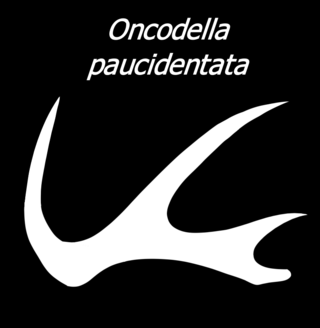The Rhaetian is the latest age of the Triassic Period or the uppermost stage of the Triassic System. It was preceded by the Norian and succeeded by the Hettangian. The base of the Rhaetian lacks a formal GSSP, though candidate sections include Steinbergkogel in Austria and Pignola-Abriola in Italy. The end of the Rhaetian is more well-defined. According to the current ICS system, the Rhaetian ended 201.4 ± 0.2 Ma.

The Carnian is the lowermost stage of the Upper Triassic Series. It lasted from 237 to 227 million years ago (Ma). The Carnian is preceded by the Ladinian and is followed by the Norian. Its boundaries are not characterized by major extinctions or biotic turnovers, but a climatic event occurred during the Carnian and seems to be associated with important extinctions or biotic radiations. Another extinction occurred at the Carnian-Norian boundary, ending the Carnian age.
The Late Triassic is the third and final epoch of the Triassic Period in the geologic time scale, spanning the time between 237 Ma and 201.4 Ma. It is preceded by the Middle Triassic Epoch and followed by the Early Jurassic Epoch. The corresponding series of rock beds is known as the Upper Triassic. The Late Triassic is divided into the Carnian, Norian and Rhaetian Ages.

Hindeodus is an extinct genus of conodonts in the family Anchignathodontidae. The generic name Hindeodus is a tribute to George Jennings Hinde, a British geologist and paleontologist from the 1800s and early 1900s. The suffix -odus typically describes the animal's teeth, essentially making Hindeodus mean Hinde-teeth.
The Norian is a division of the Triassic Period. It has the rank of an age (geochronology) or stage (chronostratigraphy). It lasted from ~227 to 208.5 million years ago. It was preceded by the Carnian and succeeded by the Rhaetian.

The Dachstein Formation or Dachstein Limestone is a geologic formation in the Alps and other Tethyan mountain ranges in Austria, Germany, Hungary, Italy, Switzerland, Slovakia and Slovenia. It preserves fossils dated to the Norian and Rhaetian stages of the Late Triassic period.
Heinz Walter Kozur was a German paleontologist and stratigrapher.
Metapolygnathus is an extinct genus of platform conodonts.
Carnepigondolella is an extinct genus of conodonts of the Late Triassic of Italy or Canada.
Epigondolella is an extinct genus of conodonts in the family Gondolellidae.
Mazzaella is an extinct genus of Late Triassic ozarkodinid conodonts in the family Gondolellidae. They are found in mid-Julian sediments of the Tethys Ocean, including strata in Europe and Turkey.
Conodonts are an extinct class of animals whose feeding apparatuses called teeth or elements are common microfossils found in strata dating from the Stage 10 of the Furongian, the fourth and final series of the Cambrian, to the Rhaetian stage of the Late Triassic. These elements can be used alternatively to or in correlation with other types of fossils in the subfield of the stratigraphy named biostratigraphy.
Misikella is an extinct genus of conodonts.
The Pignola-Abriola section is a ~63 m long stratigraphic sequence of cherty limestones deposited in the Lagonegro Basin during the latest Norian and the early Rhaetian Stages. The main outcrop is on the western side of Mount Crocetta along the SP5 road connecting the villages of Pignola and Abriola. A smaller outcrop, overlapping the central part of the main section, is located near a former railway tunnel, few meters below the road level. The Pignola-Abriola section has been recently proposed as GSSP of the Rhaetian Stage.
Neohindeodella is an extinct genus of conodonts. Neohindeodella detrei, a species of Neohindeodella, has the distinction of being the last species of conodont to finally become extinct, during the Hettangian stage of the early Lower Jurassic Period.

Oncodella is an extinct genus of Late Triassic conodont. The genus was given the type species Oncodella idiodentica by Mosher (1968), on the basis of fossils from the Late Triassic of Austria. However, Mosher (1969) later revised the species name to Oncodella paucidentata, since identical fossils from the same area were previously given the name Hindeodella paucidentata by Mostler (1967).
Mockina is an extinct genus of Late Triassic conodonts. Several species of Mockina are used as index fossils for the Alaunian and Sevatian substages of the Triassic. One species, Mockina bidentata, is considered to be ancestral to Misikella and Parvigondolella, some of the last known genera of conodonts. Mockina has occasionally been synonymized with Epigondolella based on the assumption that it represents Epigondolella specimens which live in resource-poor environments. Mockina/Epigondolella multidentata has occasionally been considered to belong to its own genus, Orchardella.
Zieglericonus is an extinct genus of Late Triassic (Rhaetian-age) conodonts, with a simple conical form.
The Catharpin Creek Formation is a Late Triassic geologic formation in Maryland and Virginia. It is found along the western edge of the Culpeper Basin, one of the largest sedimentary basins in the Newark Supergroup. Compared to the underlying Bull Run Formation, the Catharpin Creek Formation is dominated by much coarser sedimentary rocks such as sandstone and conglomerate. The base of the formation is reddish arkosic sandstone, which grades into drabber thin-bedded siltstone and shale in cyclical sequences.
Land vertebrate faunachrons (LVFs) are biochronological units used to correlate and date terrestrial sediments and fossils based on their tetrapod faunas. First formulated on a global scale by Spencer G. Lucas in 1998, LVFs are primarily used within the Triassic Period, though Lucas later designated LVFs for other periods as well. Eight worldwide LVFs are defined for the Triassic. The first two of these LVFs, the Lootsbergian and Nonesian, are based on South African synapsids and faunal assemblage zones estimated to correspond to the Early Triassic. These are followed by the Perovkan and Berdyankian, based on temnospondyl amphibians and Russian assemblages estimated to be from the Middle Triassic. The last four LVFs, the Otischalkian, Adamanian, Revueltian, and Apachean, are based on aetosaur and phytosaur reptiles common in the Late Triassic of the southwestern United States.



